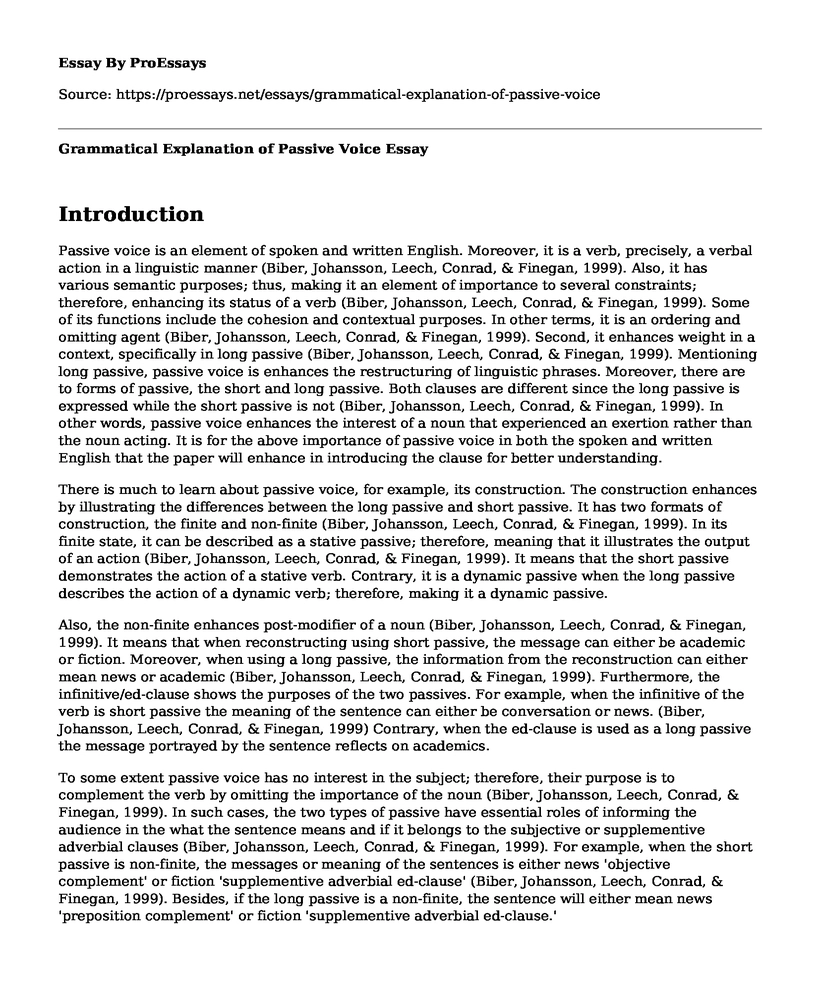Introduction
Passive voice is an element of spoken and written English. Moreover, it is a verb, precisely, a verbal action in a linguistic manner (Biber, Johansson, Leech, Conrad, & Finegan, 1999). Also, it has various semantic purposes; thus, making it an element of importance to several constraints; therefore, enhancing its status of a verb (Biber, Johansson, Leech, Conrad, & Finegan, 1999). Some of its functions include the cohesion and contextual purposes. In other terms, it is an ordering and omitting agent (Biber, Johansson, Leech, Conrad, & Finegan, 1999). Second, it enhances weight in a context, specifically in long passive (Biber, Johansson, Leech, Conrad, & Finegan, 1999). Mentioning long passive, passive voice is enhances the restructuring of linguistic phrases. Moreover, there are to forms of passive, the short and long passive. Both clauses are different since the long passive is expressed while the short passive is not (Biber, Johansson, Leech, Conrad, & Finegan, 1999). In other words, passive voice enhances the interest of a noun that experienced an exertion rather than the noun acting. It is for the above importance of passive voice in both the spoken and written English that the paper will enhance in introducing the clause for better understanding.
There is much to learn about passive voice, for example, its construction. The construction enhances by illustrating the differences between the long passive and short passive. It has two formats of construction, the finite and non-finite (Biber, Johansson, Leech, Conrad, & Finegan, 1999). In its finite state, it can be described as a stative passive; therefore, meaning that it illustrates the output of an action (Biber, Johansson, Leech, Conrad, & Finegan, 1999). It means that the short passive demonstrates the action of a stative verb. Contrary, it is a dynamic passive when the long passive describes the action of a dynamic verb; therefore, making it a dynamic passive.
Also, the non-finite enhances post-modifier of a noun (Biber, Johansson, Leech, Conrad, & Finegan, 1999). It means that when reconstructing using short passive, the message can either be academic or fiction. Moreover, when using a long passive, the information from the reconstruction can either mean news or academic (Biber, Johansson, Leech, Conrad, & Finegan, 1999). Furthermore, the infinitive/ed-clause shows the purposes of the two passives. For example, when the infinitive of the verb is short passive the meaning of the sentence can either be conversation or news. (Biber, Johansson, Leech, Conrad, & Finegan, 1999) Contrary, when the ed-clause is used as a long passive the message portrayed by the sentence reflects on academics.
To some extent passive voice has no interest in the subject; therefore, their purpose is to complement the verb by omitting the importance of the noun (Biber, Johansson, Leech, Conrad, & Finegan, 1999). In such cases, the two types of passive have essential roles of informing the audience in the what the sentence means and if it belongs to the subjective or supplementive adverbial clauses (Biber, Johansson, Leech, Conrad, & Finegan, 1999). For example, when the short passive is non-finite, the messages or meaning of the sentences is either news 'objective complement' or fiction 'supplementive adverbial ed-clause' (Biber, Johansson, Leech, Conrad, & Finegan, 1999). Besides, if the long passive is a non-finite, the sentence will either mean news 'preposition complement' or fiction 'supplementive adverbial ed-clause.'
Conclusion
To conclude, passive voice is essential since it shows the interest of a noun that experienced an action rather than the one that did it. Moreover, passive voice has its construction aid in explaining the differences between the two passives. To understand the difference between the long passive and short passives reconstruct into dynamic and stative passive respectively. Also, in the present of the non-finite clauses, the passive voice acts as a post-modifier for the noun. Finally, there are times when passive voices omit the importance of the noun but either complements the objective or supplementive adverbial ed-clause of the sentence.
Reference
Biber, D., Johansson, S., Leech, G., Conrad, S., & Finegan, E. (1999). Longman Grammar of Spoken and Written English. Howland: England. Longman.
Cite this page
Grammatical Explanation of Passive Voice. (2022, Jul 11). Retrieved from https://proessays.net/essays/grammatical-explanation-of-passive-voice
If you are the original author of this essay and no longer wish to have it published on the ProEssays website, please click below to request its removal:
- Essay Example on the White-African American Achievement Gap
- Background of Speech Delay in Toddlers - Research Paper Sample
- School Experiences Essay Example
- Recommendation to Study Abroad
- Talented Child: Outstanding Performance & Motor Skills - Essay Sample
- Essay Example on Playing Basketball: A Popular Way of Recreation for Chinese Students
- Essay Example on Computer Security Policies







